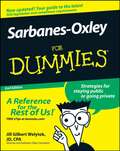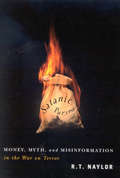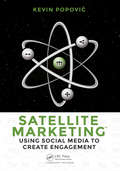- Table View
- List View
Sara Campbell (B)
by V. G. Narayanan Romana L. Autrey Julia RozovskySupplements the Sara Campbell Ltd. (A) case by introducing additional concerns with Holt. In January of 1999, Campbell received a certified letter written by Holt. The letter described Holt's own frustration in working for Campbell. Students are given context to discuss how to proceed.
Sara's Options
by Brian J. Hall Peter TufanoThis case describes the pay packages offered to Sara Becker, a graduating MBA student, including detailed information about two stock option packages (one of which is an indexed option package). She gathers the information and attempts to compare those compensation offers.
Sarah Breedlove: Changing the World
by Robert L. Simons Max SafferThis case describes the rise of Sarah Breedlove, who later called herself Madam C.J. Walker, from the cotton fields of Louisiana to the head of a successful, nationwide beauty company providing opportunity and hair care products to Black women. The case describes how Breedlove started her business, recruited sales agents, and built a strong customer base across the United States. Students will learn how Sarah Breedlove navigated life's choices to leave a lasting impact on the world.
Sarah Breedlove: Changing the World
by Robert Simons Max SafferThis case describes the rise of Sarah Breedlove, who later called herself Madam C.J. Walker, from the cotton fields of Louisiana to the head of a successful, nationwide beauty company providing opportunity and hair care products to Black women. The case describes how Breedlove started her business, recruited sales agents, and built a strong customer base across the United States. Students will learn how Sarah Breedlove navigated life's choices to leave a lasting impact on the world.
Sarah Powers at Automated Precision Products
by Michael Norris Jeffrey T. Polzer Julia Kelley Kristina TobioIn 2017, Sarah Powers, VP of Sales at an automation hardware firm, is trying to understand why some members of her sales team have been underperforming. She is tasked with analyzing her firm's email and calendar data to try to find relationships between communications and sales performance.
Sarah Powers at Automated Precision Products
by Michael Norris Jeffrey T. Polzer Julia Kelley Kristina TobioIn 2017, Sarah Powers, VP of Sales at an automation hardware firm, is trying to understand why some members of her sales team have been underperforming. She is tasked with analyzing her firm's email and calendar data to try to find relationships between communications and sales performance.
Sarah Robb O'Hagan: The Rocky Road of Passion
by Francesca Gino Jon M. JachimowiczIn November 2018, Sarah Robb O'Hagan is reeling from an unceremonious exit as CEO of Flywheel, a chain of indoor cycling studios. In the past, Robb O'Hagan had led transformational change across companies throughout the sports and fitness industry, including as President at Gatorade and Equinox. As a highly passionate fitness enthusiast, stepping into the CEO role at Flywheel felt like the pinnacle of her career, one that she would be extremely passionate about. But somewhere along the way, something went wrong, though Robb O'Hagan couldn't quite put her finger on it. Her tough experience left her questioning: She was 20 years into her career, had seemingly reached the pinnacle-only to find that this isn't what she wanted. Thinking about the next 20 years of her career was dizzying, and her ideal dream job wasn't revealing herself. What should Robb O'Hagan be looking for? What should the next step in her career and life look like?
Sarah Sullivan at Greater Marketing Solutions (GMS)
by Thomas J. Delong Paul D. Mckinnon Rebecca MccueSarah Sullivan, the new Managing Director of Greater Marketing Solutions, faces the difficult challenge of letting seven professionals go within a short span of time. In doing so she faces two greater challenges: figuring out which individuals to let go and getting her leadership team on board with her plan.
Sarah Talley and Frey Farms Produce: Negotiating with Wal-Mart (A)
by James K. Sebenius Ellen KnebelDescribes the retailer-supplier negotiations of Frey Farms Produce in its growth from a small local produce supplier to becoming a supplier for Wal-Mart, the world's largest retailer. The (A) case sets up three negotiations led by Sarah Talley of Frey Farms Produce in order to sell produce to Wal-Mart, manage price expectations during a difficult growing season, and deal with issues of co-management. The (B) case describes strategies, tactics, and the results of these negotiations, along with broader insights from the protagonist into a general approach to retailer-supplier negotiations.
Sarah Talley and Frey Farms Produce: Negotiating with Wal-Mart (B)
by James K. Sebenius Ellen KnebelAn abstract is not available for this product.
Sarah: How a Hockey Mom Turned Alaska's Political Establishment Upside Down
by Kaylene JohnsonSARAH PALIN , forty two, a hockey mom and former small-town mayor, thought her dream of making a difference in the male-dominated realm of Alaska politics was over when she clashed with the state chairman of her Republican Party and went head to head with the powerful Republican governor over issues having to do with ethics and openness in government. Yet, the former prep basketball star and one-time beauty queen could not shake a feeling that she was destined for something bigger. In 2006, she became a long-shot candidate for governor, demanding a higher ethical standard in state government. Then, fate intervened. Her populist reform message suddenly became frontpage news when a major political scandal rocked Alaska politics. Alaskans began listening to her. And they liked what they heard. This is the story of how the biggest political upset in state history propelled Sarah Palin into the governor's office.
Sarbanes-Oxley Act
by James Weber Lynn Sharp PaineDescribes the evolution and passage of the Sarbanes-Oxley Act of 2002 from the perspective of the senior counsel on capital markets for the U.S. House Committee on Financial Services.
Sarbanes-Oxley Act: Details and Evaluation
by David Lane Susan KulpPresents details related to Sarbanes-Oxley, with special emphasis on Section 404.
Sarbanes-Oxley For Dummies
by Jill Gilbert Welytok JD, CPAYou may not believe that there's a fun and easy way to comply with Sarbanes -Oxley, but once you have Sarbanes-Oxley For Dummies, Second Edition in front of you, you're sure to change your mind. This friendly guide gets you quickly up to speed with the latest SOX legislation and shows you safe and effective ways to reduce compliance costs.In plain English, this completely reliable handbook walks you through the new and revised SOX laws, introduces compliance strategies for changed and unchanged guidelines, and gives you an effective framework for implementation You'll find out how to create an efficient audit committee, purchase and use SOX software solutions, and make practical, cost-effective decisions in your initial compliance year and beyond. You'll also find proven strategies for staying public or going private and learn how to deal with all those SOX forms. Discover how to:Establish SOX standards for IT professionalsMinimize compliance costs in every area of your companySurvive a section 404 auditAvoid litigation under SOXAnticipate future rules and trendsCreate a post-SOX paper trailBolster your company's standing and reputationWork with SOX in a small businessMeet new SOX standardsBuild a board that can't be boughtComply with all SOX management mandatesComplete with invaluable tips on how to form an effective audit committee, Sarbanes-Oxley For Dummies is the resource you need to keep your SOX clean.
Saris on Scooters: How Microcredit Is Changing Village India
by Sheila Mcleod Arnopoulos Mary Ellen IskenderianShort-listed for the 2010 National Business Book Award Renowned author and journalist Sheila McLeod Arnopoulos uses her talent for investigative reporting to take us deep into the poorest villages in India. Yet, far from being passive victims of their circumstances, the women who live there have joined forces and are making astute use of microcredit to break the cycle of poverty. Microcredit was made famous by Bangladeshi economist Muhammad Yunus and consists of very small loans made primarily to women for the production of essential commodities or to start small businesses. Basing the book on a number of trips to India between 2001 and 2008, Arnopoulos shows her sense of solidarity and desire for authenticity by sharing the daily life of these villagers. The first-person account of her extensive travels focuses primarily on these women’s inspiring success stories. After witnessing many such situations first-hand, she believes that these villages have a potential strength equal to that of the modern, high-tech cities in India.
Sarvajal: Water for All
by John D. Macomber Mona SinhaEntrepreneur wrestles with business model using SMS and RFID technology, franchising, and leasing to rapidly grow off-the-grid water purification business without subsidies. The company seeks to provide potable water services to rural and urban India where the public infrastructure does not exist. Past efforts have been stymied by rural operations problems including expensive technologies, challenging maintenance issues, cash management problems, lack of capital, and lack of a business model that makes sense for retail operators without subsidy. Using a franchising model that relies on seasoned local entrepreneurs, communication technology that monitors flows and quality, payment technology that takes cash out of the equation, and a "capital light" leasing model, the company hopes to create and share a new business model. If successful, the model can be copied by other social entrepreneurs with a market-based pricing scheme to provide other forms of infrastructure in emerging markets.
Sasol: U.S. Growth Program
by Richard H.K. VietorSasol, the world's largest producer of synthetic oil from coal and gas, has announced plans to build a huge Catalytic cracker and gas-to-liquids plant in Lake Charles, Louisiana. This $21 billion venture will be the single largest foreign direct investment in US manufacturing history. The plants, on 1,600 acres adjacent to the company's existing cracker, will liquefy 98,000 barrels daily, converting ethane to ethylene and then into various specialty chemicals. The entire project depends on low gas prices engendered by the shale revolution and relatively high oil prices. The risks are copious, as is the promise.
Sasol: U.S. Growth Program
by Richard H.K. VietorSasol, the world's largest producer of synthetic oil from coal and gas, has announced plans to build a huge Catalytic cracker and gas-to-liquids plant in Lake Charles, Louisiana. This $21 billion venture will be the single largest foreign direct investment in US manufacturing history. The plants, on 1,600 acres adjacent to the company's existing cracker, will liquefy 98,000 barrels daily, converting ethane to ethylene and then into various specialty chemicals. The entire project depends on low gas prices engendered by the shale revolution and relatively high oil prices. The risks are copious, as is the promise.
Satan's Playground: Mobsters and Movie Stars at America's Greatest Gaming Resort
by Paul J. VanderwoodSatan's Playground chronicles the rise and fall of the tumultuous and lucrative gambling industry that developed just south of the U. S. -Mexico border in the early twentieth century. As prohibitions against liquor, horse racing, gambling, and prostitution swept the United States, the vice industry flourished in and around Tijuana, to the extent that reformers came to call the town "Satan's Playground," unintentionally increasing its licentious allure. The area was dominated by Agua Caliente, a large, elegant gaming resort opened by four entrepreneurial Border Barons (three Americans and one Mexican) in 1928. Diplomats, royalty, film stars, sports celebrities, politicians, patricians, and nouveau-riche capitalists flocked to Agua Caliente's luxurious complex of casinos, hotels, cabarets, and sports extravaganzas, and to its world-renowned thoroughbred racetrack. Clark Gable, Jean Harlow, Louis B. Mayer, the Marx Brothers, Bing Crosby, Charlie Chaplin, Gloria Swanson, and the boxer Jack Dempsey were among the regular visitors. So were mobsters such as Bugsy Siegel, who later cited Agua Caliente as his inspiration for building the first such resort on what became the Las Vegas Strip. Less than a year after Agua Caliente opened, gangsters held up its money-car in transit to a bank in San Diego, killing the courier and a guard and stealing the company money pouch. Paul J. Vanderwood weaves the story of this heist gone wrong, the search for the killers, and their sensational trial into the overall history of the often-chaotic development of Agua Caliente, Tijuana, and Southern California. Drawing on newspaper accounts, police files, court records, personal memoirs, oral histories, and "true detective" magazines, he presents a fascinating portrait of vice and society in the Jazz Age, and he makes a significant contribution to the history of the U. S. -Mexico border.
Satanic Purses
by R. T. NaylorNaylor argues that bin Laden's role in various terrorist activities has been grossly exaggerated and that the idea of al-Qa?idah as a well-financed, centrally directed movement is a fable akin to misconceptions about the Mafia. Satanic Purses makes clear that the myths surrounding the war on terror, especially the alleged existence of hordes of Islamic terror dollars, have led Western countries, particularly the US, to policies that create death and disorder abroad and the loss of due process and privacy at home.
Satanic Purses: Money, Myth, and Misinformation in the War on Terror
by R.T. NaylorNaylor argues that bin Laden's role in various terrorist activities has been grossly exaggerated and that the idea of al-Qa?idah as a well-financed, centrally directed movement is a fable akin to misconceptions about the Mafia. Satanic Purses makes clear that the myths surrounding the war on terror, especially the alleged existence of hordes of Islamic terror dollars, have led Western countries, particularly the US, to policies that create death and disorder abroad and the loss of due process and privacy at home.
Satelite Distribuidora de Petroleo
by Lynda M. Applegate Andrea M.A.F. MinardiMarcelo Alecrim, the owner of SAT, a gas distribution company in Brazil, envisioned many growth opportunities but lacked financial resources to pursue them. He was approaching an American private equity fund to raise money. Describes Alecrim's challenge in creating SAT and the way he leveraged his vision and a sound business model.
Satellite Marketing: Using Social Media to Create Engagement
by Kevin PopovicSatellite marketing uses multiple social media sites as a series of marketing sub-stations or "satellites." Each satellite is a stand-alone marketing effort, which means that if and when your prospects are engaged, they are being introduced to your brand, your product and services, and your community of users. Prospects presented with a call to action through satellite marketing are more likely to act because they are actively engaged with your message. Identifying opportunities for social media within integrated marketing communications, Satellite Marketing outlines a proven process to help you create an actionable strategic plan based on measurable goals. It provides business owners, CEOs, CMOs, and sales people with a comprehensive strategy for leveraging new media and integrating it with conventional marketing tactics.Traditional marketing is still important, and the context of social media will make traditional tactics more effective. Dispelling many of the myths surrounding social media, this book will help you: Develop an effective social media strategy to boost sales and brand awareness Identify and target relevant markets Create, deploy, and maintain effective satellites Measure the success of your satellite marketing campaigns The book explains why successful marketing has evolved from product-centric to customer-centric. It presents valuable lessons learned from established communications channels that apply to social media. It also details a step-by-step process to help you identify measurable goals, better understand your audience, create a strategy, select the appropriate social media, build engagement, develop a communications plan, and monitor performance.This book is written by Kevin Popović, the Founder of Ideahaus®. Mr. Popovic is a speaker, educator, and was recently named a Top 20 Digital Marketing Strategist for 2015 by the Online Marketing Institute.
Satellite Radio
by Thomas R. Eisenmann Alastair BrownIn early 2002, XM and Sirius were fighting for control of the emerging U.S. market for satellite radio. Each company targeted consumers in automobiles, providing 100 channels of CD-quality audio for a monthly subscription fee of $10-$13. Wall Street analysts predicted that these companies would be profitable by 2005-2006, but investors were increasingly skeptical of ventures that required huge, irrevocable bets on customer acquisition and infrastructure. This case describes the business models of the satellite radio companies, the technology they employed, and their target markets. Poses questions about their pricing strategies, strategic partnerships with auto manufacturers, and whether they should develop interoperable radios that receive either company's signals.
Satera Team at Imatron Systems, Inc. (A)
by Teresa M. Amabile Elizabeth A. SchatzelEscalating conflict has erupted within the Satera product development team, resulting from the conflicting cognitive styles of the two senior mechanical engineers. The conflict has taken a toll on both project progress and team morale, endangering one of the most important initiatives at Imatron Systems, Inc. After discussing the situation with VP of R&D Rick Levinger, team leader Gary Pinto realizes he must take decisive action. This case presents a profile of the company, the team, the Satera project, and the team members, focusing on Pinto and the dueling engineers. Through a detailed description of their vastly different problem-solving preferences, and the interactions in which those differences become most apparent, the conflict presents a common problem that managers must face when working with creative people on creative projects.






